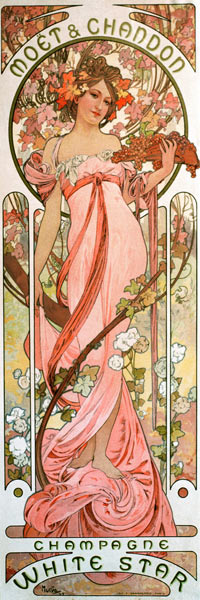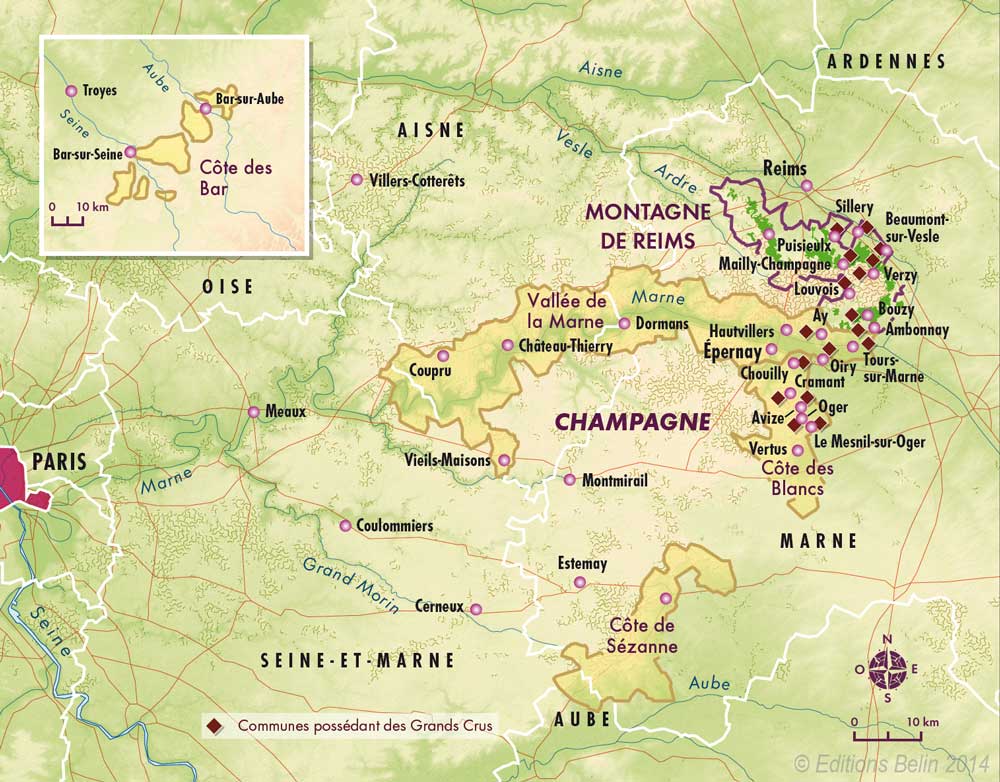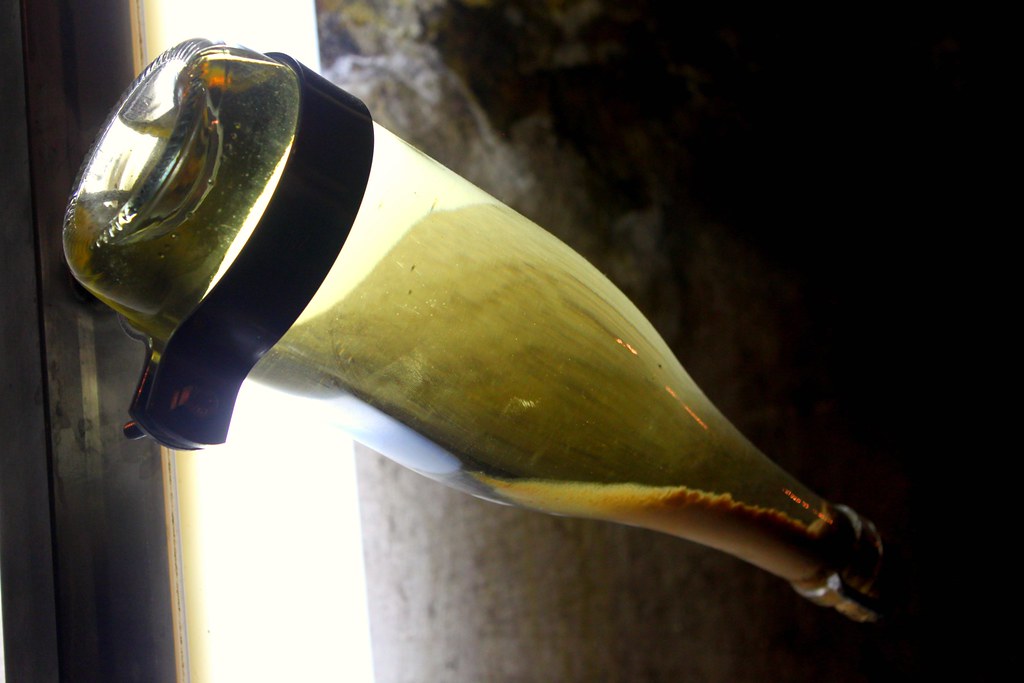- Where does Champagne come from?
« There is Champagne only from Champagne region *1»
* 1. Law voted in the French Assembly in 1927.

2. Where is Champagne region Champagne located?
The Champagne region is located about 100 km northeast of Paris. It is the second most northerly vineyard of France, after the one of Moselle AOC.
At your disposal, four cards, with an increasingly close-up view.
The Champagne region is the one shown in orange, No. 6, top right. Paris is located just below No. 6, at the confluence of the Marne and the Seine rivers.

| 1 Alsace 2 Bordeaux 3 Beaujolais 4 Bourgogne | 5 Bugey 6 Champagne 7 Corse 8 Jura | 9 Languedoc 10 Lorraine 11 Loire 12 Provence |

Keywords
- Discovery: The birth of Champagne dates back to the late 17th century. The main feature is that the fermentation process of the bottled grape allows the wine to sparkle. The quality of champagne is measured by the vintage, the grape variety, the vintage and the terroir.
- Surface: Covers 34,300 hectares, around and south of the city of Reims, 3.5% of the area of the French vineyard.
- 7 grape varieties: Chardonnay, Pinot Noir & Pinot Meunier represent more than 99.5% of the grape used. Arbane, Petit Meslier, Pinot Blanc & Pinot Gris are allowed too.
- 7 types: from driest to sweetest:
| Brut Nature | Or Zero dosage. No sugar added and less than 3 grams of residual sugar per litre. The driest Champagne. Lively, fresh and dry. |
| Extra Brut | Very Dry – Between 0 and 6 grams of sugar per liter. |
| Brut | 7 to 11 gr. of sugar/liter |
| Extra-Dry | Or Extra-Sec – Medium Dry – Between 12 & 17 gr. of sugar/liter. |
| Dry | Or Sec – Between 17 & 32 gr. of sugar/liter. |
| Demi-Sec | Between 32 & 50 gr. of sugar/liter. Sweeter, this type of champagne accompanies perfectly your desserts. |
| Doux | More than 50 gr. of sugar/liter |
To these traditional Champagnes, we also have the Rosé Champagne, which is part of the different kinds of champagnes.
- Five main regions (map above): The place of production of Champagne is strictly defined by law (1927), limited to the region of Champagne only.
- the Montagne de Reims
- the Marne valley
- the Côte des Blancs
- the Côte des Bars
- the Côte de Sézanne
Glossary
- Terroir: The vine grows on a thick layer of chalk deposited in the secondary area, around 200 million years ago, at the time of fragmentation of the Pangaea, before the appearance of humanity. It’s this particular chalk that brings the mineral elements and restores the heat of the sun, two elements necessary for the good evolution of the vine in a region with continental climate. Which is why Vincent Charlot says that when he drinks
- Cru: Like the Climat in Burgundy, the Cru is a combination of three elements: its geological and hydrometric characteristics and its exposure.
In Champagne, the concept of “Cru” applies to a group of villages (Commune), unlike the region of Bordeaux, where a “Cru” is limited to a terroir, a castle; unlike the region of Bourgogne where it applies to a village (Volnay, Pommard, Nuits-Saint-Georges…).
The quality of a “Cru” is depending on the type of soil on which the vine is planted, the sun exposure, and the finale quality of the grapes. The best parcels are called “Grand Cru”. The chalkiest terroirs produce the best grapes.
Here was the sea. It deposited this limestone, of marine origin, which plays a role of thermal regulator and drainage for the Champagne vineyard.
There are 319 communes, classified in 3 categories ranking from 100% to 80%, according to the quality of the grapes (not to the quality of champagne).
Today, among these 319 wine-growing communes from the Champagne region:
- 17 are classified as “Champagne Grand-Cru”. Champagne Grand Cru is made from grapes harvested in these communes classified 100%. 11 of them are located in the Montagne de Reims and 6 in the Côte des Blancs. 4000 hectares of vineyard, 14% among the 34300 hectares of the appellation since 1927.
- 44 are classified “Champagne Premier-Cru”. Champagne Premier Cru is made from grapes harvested in communes classified 90 to 99%. They are located in the Montagne de Reims, Côte des Blancs and around Epernay. 5000 hectares of vineyard, approximately 17,6% of the appellation. The mention Grand Cru or Premier Cru may appear on the label.
- The 258 remaining communes, listed « non-classified », represents 21,000 hectares of the Champagne vineyard. They have less strict specifications than the two previous Crus. Only the word Champagne appears on the label.
This scale reflects the quality of the grapes, not that of the Champagne. It is used to establish the selling price per kilo of grapes to merchants.
–
The five (4 + 1 unknown) main regions – Brief description
Montagne de Reims – Chalk deeply buried – Pinot Noir – Power, structure & nobility
The slopes of the Montagne de Reims, mostly exposed to the south, are implanted on soils whose chalk is deeply buried. The dominant grape variety is Pinot Noir. Champagnes are renowned for their power, structure and nobility.
Côte des Blancs – Chalk everywhere – Chardonnay – Finesse & elegance
The outcropping chalk is everywhere, offering a veritable reservoir of water and heat from the subsoil. The Côte des Blancs gives birth to popular Champagne, full of vivacity and spirit, with light and delicate aromas, symbols of finesse and elegance. Here, a unique grape variety reigns supreme: Chardonnay.
Which is why Vincent Charlot says that drinking his L’Or des Basses Ronces Blanc de Blancs Extra Brut, one of his finest Cuvées, a single white vintage whose old Chardonnay vines grow on this type of chalky terroir, is like « drinking the memory of the ocean. It makes you feel like walking on a beach at low tide, taking in gulp after gulp of fresh iodine air ». 200 million years after… Is that not extraordinary?
Marne valley – Clay-limestone soils – Pinot Meunier – Fruitiness & great suppleness
The hillsides of the Marne valley are located on clay-limestone soils. The dominant grape variety is Pinot Meunier. Thanks to their great diversity, champagnes from the Marne valley have a seductive bouquet, fruitiness and great suppleness.
Côte des Bar – Clay and limestone – Pinot Noir – Roundness & complex aromas
The marly basements, a natural mixture of clay and limestone, are mainly planted with Pinot Noir. The champagnes of the Côte des Bar are wines of character, with beautiful roundness and complex aromas.
Côte de Cézanne – 75% Chardonnay & Pinot Noir
Like the Côte des Bar, the Côte de Sézanne wine region is little known. However, it’s a very interesting part of Champagne, in strong contrast to other regions, especially with the Côte des Blancs. Indeed, the Côte de Sézanne is part of the “humid Champagne”, an area where marshes and forests are very present. This is the only wine-growing region, along with the Côte des Bar, to produce Le Rosé des Riceys, Riceys rosé, a very interesting and unique rosé.
As Chardonnay dominates, Champagnes from this area are “Blanc de Blancs”. Blanc de Blancs from Sézannais are usually described as more “tropical” and aromatic, with lower acidity, than those from the Côte des Blancs area.
Method of elaboration
- Harvesting, pressing, fermentation and blending (l’Assemblage)
After harvesting, pressing and fermentation in tanks, the juices from the different grape varieties, crus and years are blended. The blend makes it possible to maintain a consistent style, while each harvest is different in terms of quantity and quality.
For this, reserve wines are used: each year, part of the harvest is kept (about 2-3 years) in tanks. These more advanced wines are blended each year with wines from the last harvest. Only vintage champagnes are single-year blends. They are only made in good years. All the Champagne of Vincent Charlot that Bacchus Global proposes are all vintage.
- The drawing of the wine: “le tirage”
It is the bottling of the wines, six months later. It cannot be carried out before 1 January following the harvest. A “liqueur de tirage”, which contains selected yeasts and sugar, is added to the wine to trigger a new fermentation in the bottle. The bottle is then closed.
- The second fermentation: “la prise de mousse”
“Traditional method” or “Champenoise method”, consists of a second fermentation in bottle, fermentation during which Champagne acquires its foam, a phenomenon known as “prise de mousse”. Thank you, Brother Dom Pérignon!
- The maturation
When the foaming is complete, the yeasts die and form a deposit. During their lifetime, they have evolved the aromas and improved the taste qualities of the champagne. The maturation time varies according to the type of assembly and the desired result. For the sake of quality, the legislation requires a minimum period of 15 months after drawing, including 12 on lees, for non-vintage champagnes. 3 years for vintage champagnes.
In practice, this statutory timeframe – already significant compared to other sparkling wines – is nearly always longer in Champagne: 2-3 years for non-vintage wines and 4-10 years for vintage Champagne.
- The riddling : “le remuage”
When the maturation is finished, the deposit that disturbs the champagne must be removed. Remuage, a technique developed by Madame Clicquot, consists in lowering the deposit into the neck of the bottle to be able to expel it. Each bottle is placed horizontally on a wooden stand, then it is turned every day. These movements allow the heavy deposit to attract the light deposit to the finest particles and thus make the champagne perfectly clear. In addition to the balance movement, the bottle is gradually straightened vertically, which allows the deposit to descend to the neck. The operation lasts about 1 month.

- The Disgorgement: “Le dégorgement”

The disgorgement consists of opening the bottle, upside down at the end of the stirring process, to expel the deposit. It is done by freezing the cervix. The bottle neck is immersed in a solution at -25°C that freezes the deposit. Then the bottle is turned and the capsule removed. Under pressure (6 bar inside the bottle), the ice is expelled.
- The dosage
The dosage consists of adding a liqueur, a mixture of excellent cane sugar and reserve wines, to fill the few centilitres lost after disgorgement. The amount of liqueur added for dosing depends on the type of champagne desired.
The Champagnes with a low sugar content (less than 6 g/l) are very expressive and of a very high quality. Elegant and refined, they stand out thanks to a beautiful acidity that has made their reputation among connoisseurs.
An “Extra Brut” Champagne is ideal to awaken the taste buds as an aperitif. It can be served with raw fish, seafood and refined meats.
The Champagne of Vincent CHARLOT, the Champagne Bacchus Global proposes, are:
- all “Extra Brut” ones – means no sugar that masks the quality of the grapes was added;
- all Vintage one, which means they are matured for at least three years (15 months for a non-vintage Champagne);
- all biodynamically farmed.
▲ Only 2% of the Champagne vineyard are biodynamically farmed
Vincent CHARLOT has 3 Rosés de Saignée Extra Brut (no sugar added):
1 – Vincent Charlot “Le Rubis de la Dune”, 80% Pinot Meunier, 20% Pinot Noir
2 – Vincent Charlot “L’Ecorché de la Genette”, 90% Pinot Meunier, 10% Pinot Noir
3 – Charlot-Tanneux “Rosé de Saignée Extra Brut”, 90% Pinot Meunier, 10% Pinot Noir
A “Rosé de Saignée“ is the vinification of red grapes (Pinot Noir & Pinot Meunier). Maceration is short, lasting just one or two days. Then, the vat is “bled”, which means that part of the juice is extracted and transferred to a different vat. There, it ferments again. This helps produce particularly dark rosés. A “Rosé de Saignée” is therefore fatter than other rosés, and has greater volume on the palate. Unlike a “Rosé d’assemblage”, the vinification process involves leaving the clear juice to macerate in contact with the skins for 12 to 24 hours.
By comparison, a “Rosé d’assemblage” is the blending of a white wine, before the second fermentation, with around 5 to 20% red from Champagne Region. This blend gives a Rosé color. No maceration, no skin contact, less body.
When tasted, a “Rosé de Saignée” Champagne is richer, windier and fruitier. The tannins imparted by the skins during vinification make for a more tannic wine than a “Rosé d’assemblage”. The color is also more pronounced.
More concentrated, a Champagne “Rosé de Saignée” is considered a highly expressive wine, reflecting the singularity of a well-defined terroir as it’s not a blend.
- Corking
Finally, the bottles are sealed with a cork stopper held in place by a metal wirehood. All that remains is to dress the bottles for shipment.
♦
The mentions
- AOC: Champagne is the only AOC in France not to be subject to the obligation to display the mention AOC on its label.
- Millésime (Vintage): Year of harvest
- Blanc de Blancs: Champagne made only from white grapes
- Blanc de Noirs: Champagne made only from black grapes
- Rosé: Champagne made by blending or bleeding (see above)
What about the difference Crémant & Champagne?
If there is Champagne only from Champagne, there is Crémant from many different regions of France: Alsace, Burgundy, Loire, Limoux, Jura, Bordeaux, Die (the famous Clairette de Die) or Savoie, elaborated with many different grape varieties.
Otherwise, the differences are tenuous. Same “Méthode traditionnelle” or “Méthode Champenoise” – second fermentation in bottle – an ageing of twelve months instead of fifteen.
Then, everything depends on the talent of the producer, his know-how, the grape varieties used, the terroir.
The Crémants of Bruno Dangin that Bacchus Global proposes are made with the same 3 grape varieties as those used for Champagne – Pinot Noir, Pinot Meunier & Chardonnay – on a terroir which, until 1919, was part of the Champagne harvesting area.
Indeed, its lands, before the law of May 6, 1919, produced grapes intended for the elaboration of Champagne (the AOC, which delimits the Champagne area, didn’t exist at this time. It was created in 1935 only).
“This law respects the administrative limitations of the departments but it does not take into account the geological and climate limits that make this vineyard the continuity of the Champagne vineyard of the Côte des Bars” wrote Georges Calvet, in “La vigne et le vigneron de la côte du Châtillonnais).
Its terroir, geologically and climatically, is therefore ideally suited to the production of wines of a quality comparable to those produced before 1919, i.e., Champagne!
Bruno Dangin, whose family produces Champagne and for whom he has worked for 35 years, uses all his know-how on his lands: same way of working, same winemaking requirements as in the neighboring department. We naturally find his touch of winemaker in these bottles signed «Domaine Bruno Dangin».
It is therefore natural that these bottles, signed “Domaine Bruno Dangin”, reflect his signature as a Champagne winemaker.
All its Cuvées are “Brut Nature”, Extra Brut” or “Brut” ones. No, or very little added sugar that masks the quality of the grapes.
An example about its Cuvée Blanche: « Although this is legally a Crémant, it drinks much more like the Pinot Noir based bubblies from the Aube in southern Champagne in terms of its length and complexity. The soils in Dangin’s vineyards, which he farms organically, are identical to what you find across the Champagne border. In the cellar these bottles are treated exactly as you’d expect from a top grower producer in Champagne. You won’t find a better value in the world of sparkling wine. *3»
*3. https://www.mwcwine.com/wines/Bruno-Dangin-Cremant-de-Bourgogne-Cuvee-Blanche-w0370139yb
How to store Champagne?
Once you’ve chosen your Champagne, you can store it for several years, even though, unlike other types of wine, Champagne is delivered at maturity and is not intended to be kept for long.
To preserve it, it’s important to store the bottle horizontally, in a cool place (maximum 15°C) at a constant temperature, away from light, noise, bad smells and vibrations.
Voilà!
Glossary on line
Sitography
– in English
- https://www.champagne-terroir.fr/en/106-extra-brut
- Official website of the Champagne Committee – English version
https://www.champagne.fr/en/about-champagne/how-champagne-is-made
– in French
Anselme Selosse explains the disgorging of his Champagne
♣
Quiz: Place the good wine regions of France in their right place.

| 1 2 3 4 | 5 6 7 8 | 9 10 11 12 |
Alsace, Bordeaux, Bugey, Beaujolais, Champagne, Bourgogne, Corse, Jura Lorraine, Loire, Provence, Languedoc
How many bottles of Champagne were produced in 2022?
*4. 326 million bottles in 2022.
(Dr.FX)

